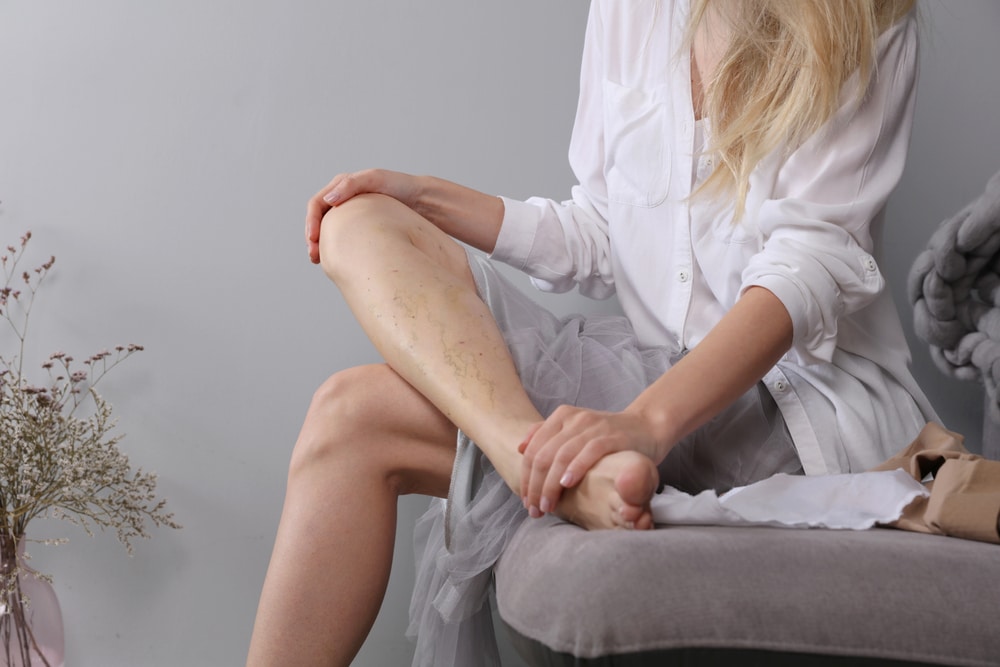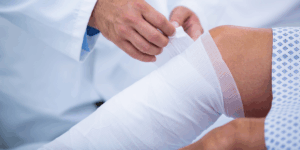| Compression therapy is a safe, effective, and non-invasive way to manage the symptoms of chronic venous insufficiency, helping to reduce leg pain, swelling, and fatigue while improving circulation. Whether used alone or alongside other treatments, it plays a vital role in maintaining healthier veins and preventing complications. If you’re experiencing signs of poor vein health, the team at Miami Vein Institute is here to help. Schedule a consultation today to learn how compression therapy and other personalized treatment options can support your long-term vein health. |
Living with chronic venous insufficiency (CVI) can be uncomfortable and frustrating. From aching legs and swelling to skin changes and visible veins, the symptoms can interfere with your daily routine and lower your quality of life. But there’s a simple, non-invasive solution that can make a meaningful difference—compression therapy.
We specialize in helping people manage and treat chronic venous conditions with compassionate, personalized care. In this blog post, we’ll walk you through what chronic venous insufficiency is, how compression therapy works, and why it’s a cornerstone of conservative vein care. Whether you’ve just been diagnosed or are looking to improve your current treatment plan, this guide will help you better understand your options.
What Is Chronic Venous Insufficiency?
Chronic venous insufficiency is a condition that occurs when the valves in your leg veins don’t function properly. Normally, these valves help return blood from your legs back up to your heart. But when they become weak or damaged, blood can pool in the veins instead of circulating efficiently.
This pooling of blood leads to symptoms like:
- Swelling in the lower legs and ankles
- Aching, cramping, or heaviness in the legs
- Skin discoloration or texture changes
- Development of varicose veins
- Leg ulcers in severe cases
CVI is more common than you might think. It often develops gradually and can be exacerbated by factors such as age, genetics, pregnancy, prolonged standing, and obesity. If left untreated, CVI can progress and lead to more serious complications, making early intervention and proper management crucial.
How Compression Therapy Works
Compression therapy is a first-line treatment for CVI and other vein-related conditions. It involves wearing specially designed garments—typically compression stockings or socks—that apply gentle, graduated pressure to the legs. This pressure helps the veins and muscles move blood more efficiently back toward the heart.
Here’s how it works:
- Improves Circulation: The gentle pressure from compression garments helps push blood upward through the veins, counteracting gravity and promoting better blood flow.
- Reduces Swelling: By preventing fluid from pooling in the legs and ankles, compression therapy can significantly reduce swelling (edema) and discomfort.
- Relieves Symptoms: Regular use of compression stockings can ease leg pain, cramping, heaviness, and fatigue associated with poor circulation.
- Prevents Progression: Compression therapy helps slow or prevent the progression of venous disease, reducing the risk of complications like varicose veins or venous ulcers.
Types of Compression Garments
Not all compression garments are created equal. Depending on your needs and the severity of your condition, your doctor may recommend different types or levels of compression:
1. Compression Stockings
These are the most common garments used in CVI treatment. They are available in different lengths—knee-high, thigh-high, or full pantyhose—and come in various compression levels, measured in millimeters of mercury (mmHg). Common ranges include:
- Mild Compression (8–15 mmHg): Ideal for daily use, travel, or mild symptoms.
- Moderate Compression (15–20 mmHg): Helps relieve minor swelling and fatigue.
- Firm Compression (20–30 mmHg): Recommended for managing varicose veins and moderate CVI symptoms.
- Extra Firm Compression (30–40 mmHg and above): Used for severe CVI, leg ulcers, or after vein procedures.
2. Compression Wraps or Bandages
In more advanced cases or when custom garments are needed, your doctor may recommend adjustable wraps or bandaging systems. These offer flexible support and are often used in wound care or ulcer management.
3. Custom-Fitted Garments
For patients with unique needs or limb shapes, custom compression garments can be designed for optimal fit and effectiveness.
We’ll guide you through selecting the right type and compression level based on your condition, lifestyle, and goals.
Benefits of Compression Therapy in CVI Management
Compression therapy offers several key benefits for patients with chronic venous insufficiency:
1. Non-Invasive and Drug-Free
Unlike surgical treatments or medications, compression therapy is a non-invasive approach that carries minimal risk and can be easily incorporated into your daily routine.
2. Enhances Comfort and Mobility
By reducing swelling and pain, compression garments can make walking and standing more comfortable, helping you stay active and maintain a healthier lifestyle.
3. Prevents Ulcers and Complications
In moderate to severe cases of CVI, skin ulcers can develop due to prolonged swelling and poor circulation. Compression therapy helps prevent these complications by maintaining better blood flow.
4. Complements Other Treatments
Compression therapy is often used alongside other treatments like sclerotherapy, laser therapy, or lifestyle changes to provide comprehensive vein care. It can also be used after procedures to support healing and reduce the risk of recurrence.
Tips for Wearing Compression Garments
To get the most out of your compression therapy, consider the following tips:
- Wear Them Daily: For best results, wear your compression stockings every day, especially during waking hours when you’re standing or walking.
- Put Them On in the Morning: Swelling is usually minimal when you first wake up. Putting your stockings on first thing in the morning helps prevent fluid buildup throughout the day.
- Wash Them Gently: Hand wash or use a gentle cycle with cold water. Avoid high heat when drying to preserve elasticity.
- Replace Them Regularly: Compression garments lose effectiveness over time. Most should be replaced every 3 to 6 months, depending on wear and care.
If you have trouble putting on your stockings, there are assistive devices and techniques that can help. Our team can show you the best methods to use and recommend tools that make the process easier.
When Compression Therapy Alone Isn’t Enough
While compression therapy is an excellent way to manage symptoms, it doesn’t cure chronic venous insufficiency. In some cases, especially if your symptoms worsen or you develop more serious issues, you may need additional treatments. These may include:
- Sclerotherapy: A minimally invasive injection treatment that closes off damaged veins.
- Endovenous Laser Therapy (EVLT): A laser-based treatment that seals larger varicose veins.
We take a comprehensive approach to vein care. We’ll work with you to determine if compression therapy alone is enough or if additional treatments would provide better long-term results.
Take the First Step Toward Healthier Veins with Miami Vein Institute
Compression therapy is a powerful, non-invasive tool in the fight against chronic venous insufficiency. By supporting your circulation, reducing swelling, and relieving discomfort, it can significantly improve your quality of life.
If you’re experiencing leg pain, swelling, or other symptoms of poor vein health, don’t wait to seek help. The earlier you intervene, the more effective your treatment options will be. At Miami Vein Institute, we’re here to help you take control of your vein health with personalized care and advanced solutions.
Schedule your consultation today to find out if compression therapy—or a combination of treatments—is right for you. Let us help you get back to feeling your best.
Frequently Asked Questions (FAQ)
Do I need a prescription for compression stockings?
For mild compression, you can purchase over-the-counter stockings. However, medical-grade compression (20 mmHg and above) often requires a prescription for proper fit and effectiveness.
Can compression therapy cure chronic venous insufficiency?
Compression therapy helps manage symptoms and slow disease progression, but it does not cure CVI. It’s most effective when combined with lifestyle changes or additional treatments if needed.
Is compression therapy uncomfortable?
Properly fitted compression stockings should feel snug but not painful. Our team can help ensure you get the right size and pressure level for comfort and results.
How long should I wear compression stockings each day?
Most people benefit from wearing compression stockings during the day, especially when active. You typically do not need to wear them while sleeping unless directed by your doctor.

John W. Dr. Chang, MD, serves as the Partner and Medical Director at Miami Vein Institute, a premier center specializing in vein treatment in South Florida. With a focus on providing high-quality care and ensuring patient safety and satisfaction, Dr. Chang has helped establish Miami Vein Institute as a leading destination for minimally invasive vein treatments. At Miami Vein Institute, Dr. Chang offers a comprehensive range of minimally invasive procedures, including Endovenous Laser Treatments (EVLT) and Sclerotherapy, to address various vein-related concerns. His expertise in both general and cosmetic surgery, combined with specialized training in vein treatments, allows him to tailor treatment plans to meet each patient’s individual needs. Dr. Chang’s commitment to excellence is reflected in his meticulous attention to detail and dedication to staying updated with the latest advancements in vein care technologies. He is certified in a wide array of cosmetic surgery procedures and is a certified trainer for various advanced techniques. Dr. Chang’s affiliations with prestigious medical associations underscore his commitment to upholding the highest standards of medical excellence. With a focus on patient well-being and personalized care, Dr. Chang ensures that every patient receives honest, expert guidance throughout their treatment journey. His passion for providing the best possible care is evident in his commitment to patient satisfaction and achieving optimal outcomes.


